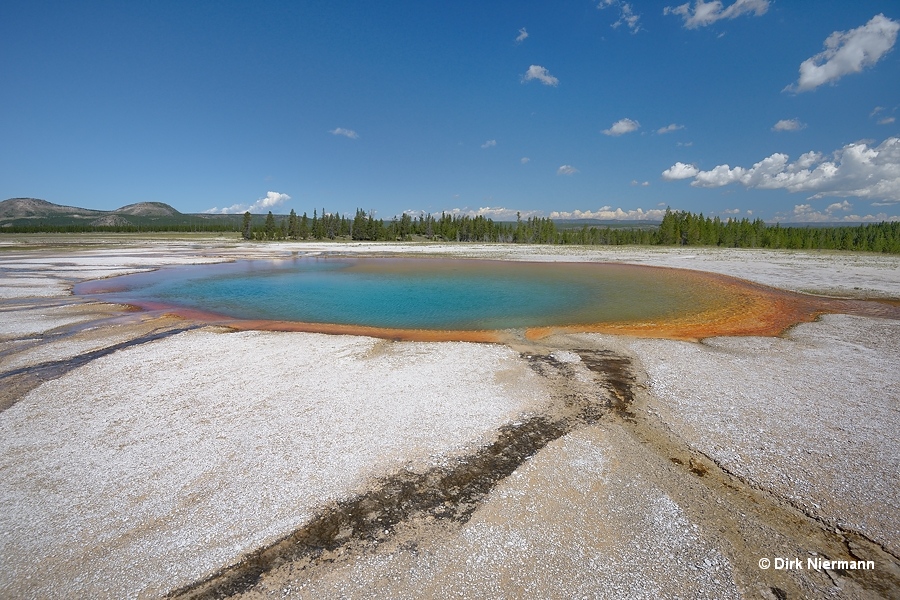Midway Geyser Basin, Excelsior Group
Excelsior Group is by far the most popular destination within Midway Basin and therefore often quite crowded. The 0.8 km (0.5 mile) loop walk allows a more or less close look at the four main features, except for Indigo Spring, which is not visible from the boardwalk.
After crossing Firehole River, the trail runs along Excelsior Geyser and its runoff. Standing next to the oval, more than 90 m (300 feet) wide crater is very impressive, even if you can catch only a glimpse of the feature through the dense steam. This already indicates that Excelsior Geyser is really hot, around the boiling temperature of 93 °C (199 °F) at a considerable discharge rate of 250 liters per second (4,000 US gallons per minute). In the 1880s, eruptions of Excelsior were among the largest of any Yellowstone geysers, reaching up to 90 m (300 feet) high. Unfortunately, the last eruptions occurred in 1985, and they failed to reach the maximum size.
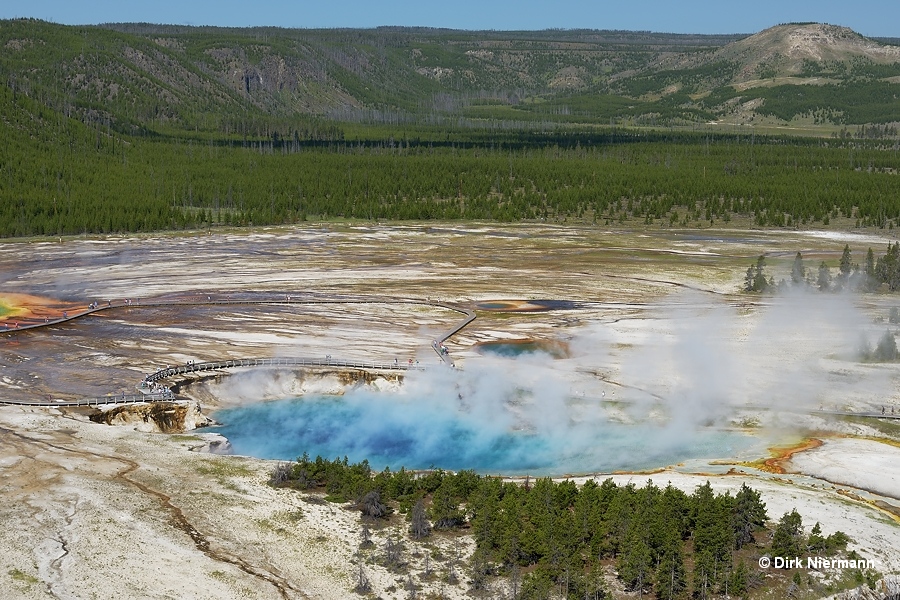
As mentioned before, Indigo Spring southeast of Excelsior Geyser cannot be seen from the loop walk. The best observation spot is the top of Midway Bluff, a hill east of the highway, providing a spectacular sight over the entire group and a suitable viewing angle for Indigo. But the beauty also has a dark side. Probably it was the 88 °C (191 °F) hot Indigo Spring, into which a 52-year-old man from Texas fell and was scalded to death in August 1928. This happened decades before the first boardwalks were built in the Excelsior Group.
(Update 2016: Midway Bluff has been permanently closed to public access since summer 2016.)
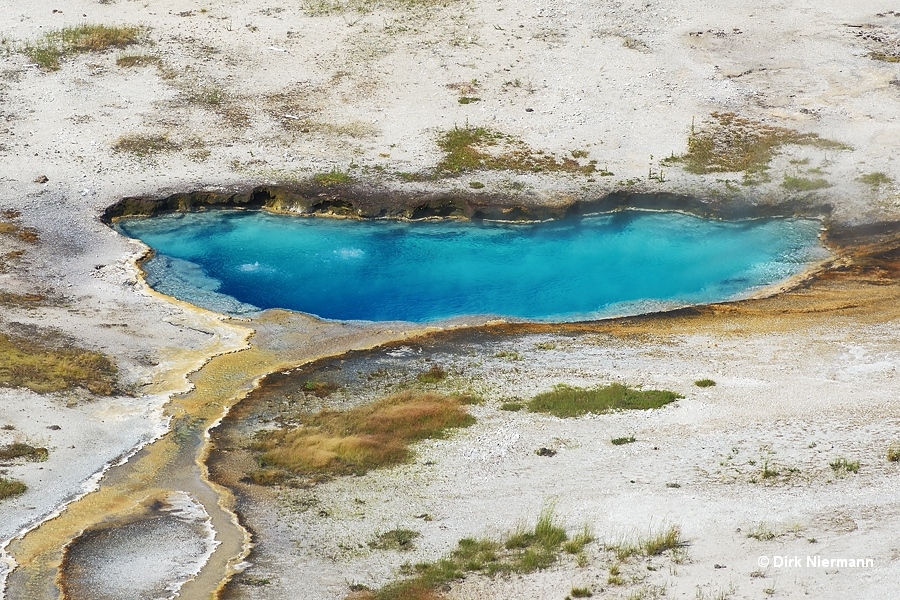
Grand Prismatic Spring is one of the most famous landmarks of Yellowstone. Dimensions of 113 m (370 feet) in maximum diameter and approximately 49 m (161 feet) in depth make it the largest hot spring of the park and the third largest worldwide. If you now wonder how the depth measurement of such an extensive hot spring could be done, the answer is as simple as scary. In 1994 park geologist Rick Hutchinson navigated the "Little Dipper", a small row boat made of fiberglass-coated plywood, over the scalding hot water to the center of the spring and plumbed the pool's deepest point. Probably, not many people did envy him for that hell of a job.
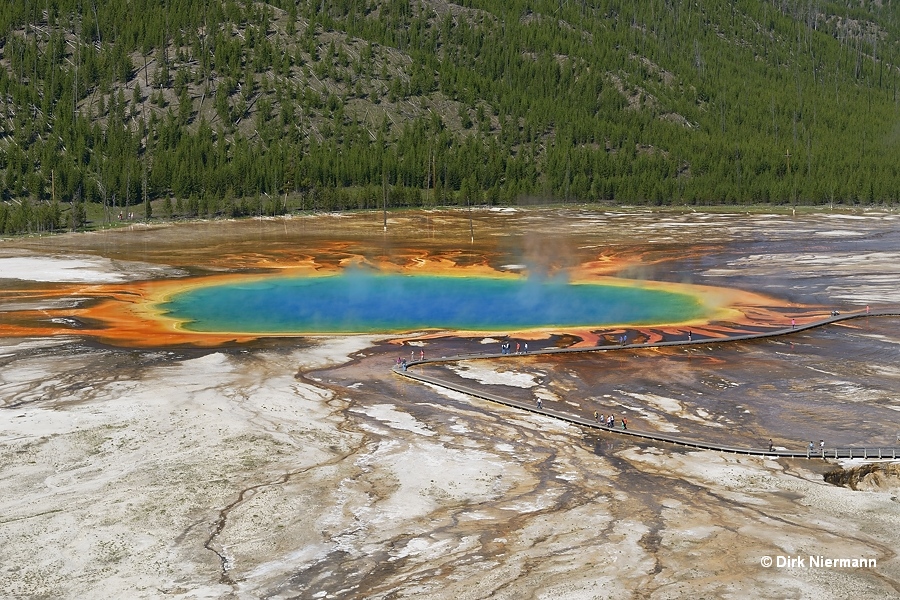
At a surface temperature of 70 °C (160 °F) Grand Prismatic Spring does not release as much steam as Excelsior Geyser, and it has never shown any geyser activity. However, if you want to spot larger parts of the spring's water surface, you should pick the hours beween noon and late afternoon of a warm, sunny day.
One of the most surprising facts and the origin of its name is that by a freak of nature the color sequence from the spring's center to the rim is in conformity with that of a rainbow and of sunlight dispersed by a prism. Well, to be honest this is not a real coincidence because in both cases, spring and light spectrum, the color gradient from blue to red is running from high to low energy, represented by temperature or wavelength, respectively.
Another nice feature is the pronounced reflection of the blue color of the water in the steam. But that's not all: Miraculously, the spring's edges and the area beyond are nearly perfectly horizontally oriented, so water drains almost equally into all compass directions, which is the icing on the cake in terms of its breathtaking appearance. In this context it may be interesting to know that on August 17th, 1959, the Hebgen Lake earthquake tilted Grand Prismatic Spring and its surroundings as a whole by approximately 2 cm (1 in) and shifted the overflow to a predominantly easterly direction. This major impact of a hardly notable tilt emphasizes how accurate the horizontal alignment of the spring's rim really is.
The new observation platform on the hillside southwest of Grand Prismatic Spring, completed in summer of 2017, offers fascinating views down from above on the spring as a whole and on its sections. What you see if you are looking closely seems to be as exotic as a scenery on a planet in a different solar system. It does not only appear to be so, though, actually it is a kind of extraterrestrial environment on earth, a world of bacteria and archaea which is likely to be found in a similar fashion on exoplanets, too.
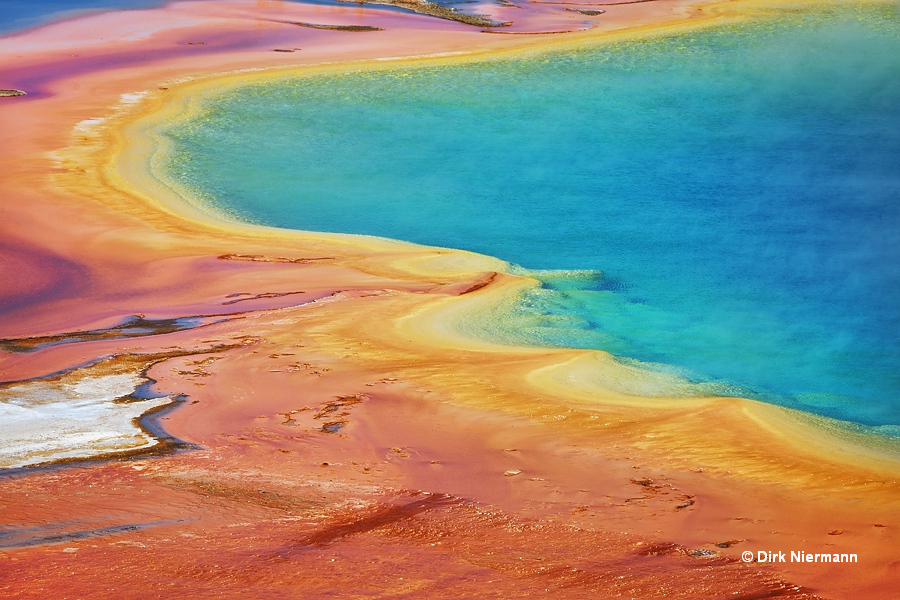
Grand Prismatic Spring hides many secrets, the most exceptional of which may be behind the mesmerizing color pattern of the shore area. Both colors and their brilliance are not always the same, they vary with the change of weather and of seasons. The brightest and most saturated hues are to be observed when sunny and warm weather has lasted for a longer time, whereas gloomy, cold periods give rise to a dull appearance. This phenomenon can be attributed to the fact that microbe communities along the spring‘s rim, adapted to its mildly alkaline conditions (pH 7.0 to 8.3), vary in species composition and pigmentation depending on water temperature and on exposure to sunlight and species-specific nutrients or toxins. This does not only lead to the growth of different species of microbes with increasing distance to the spring's rim but also to a vertical sequence of various species through the up to one inch thick, laminar (layered) bacterial mats.
The outer brown areas of the spring, supplied by already cooled effluent water of 30 °C to 45 °C (86 - 113 °F), feature stratiform mats of brownish-black Calothrix cyanobacteria. These microbes protect themselves against the sun by the dark brown pigment scytonemin.
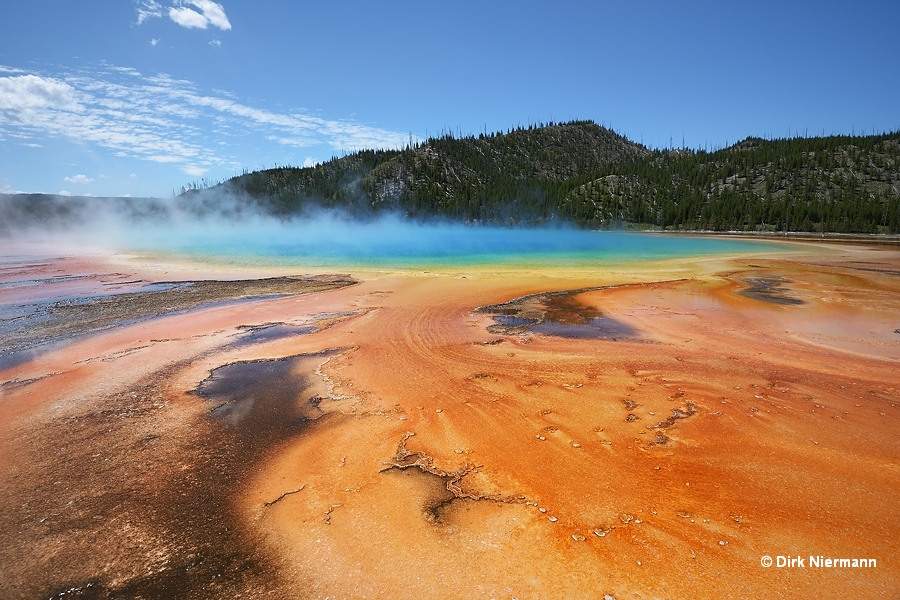
The lower, 45 °C to 60 °C (113 - 140 °F) warm outflow channels and areas of Grand Prismatic Spring are dominated by long streamers and filamentous mats of orange-tan Phormidium laminosum cyanobacteria. Just as Calothrix they use pigments as sunscreen, but in this case orange to red carotenoids. Phormidium is associated with orange (in winter green) filaments of Chloroflexus aurantiacus, which prefer the same temperature range and often form the second uppermost layer below Phormidium within the laminar bacterial mats. Chloroflexus applies green bacteriochlorophylls to carry out photosynthesis. Closer to the spring at a temperature range of 52 °C to 75 °C (126 - 167 °F) biofilms of Synechococcus cyanobacteria perform oxygenic photosynthesis and fix carbon dioxide. 75 °C (167 °F) also represents the upper temperature limit of photosynthesis in alkaline thermal springs. The thin, uppermost layer of Synechococcus dominated mats is often yellow-green, the underlying dark green and the bottom layers are dark orange.
The brightly yellow, but occasionally pink or red colored streamers of Thermus aquaticus prefer even higher temperatures of up to 80 °C (176 °F) at the very edge of the spring and likely they are continuing toward the bottom. This hyperthermophilic bacterium consumes other mircobes and organic matter to grow and sustain life.
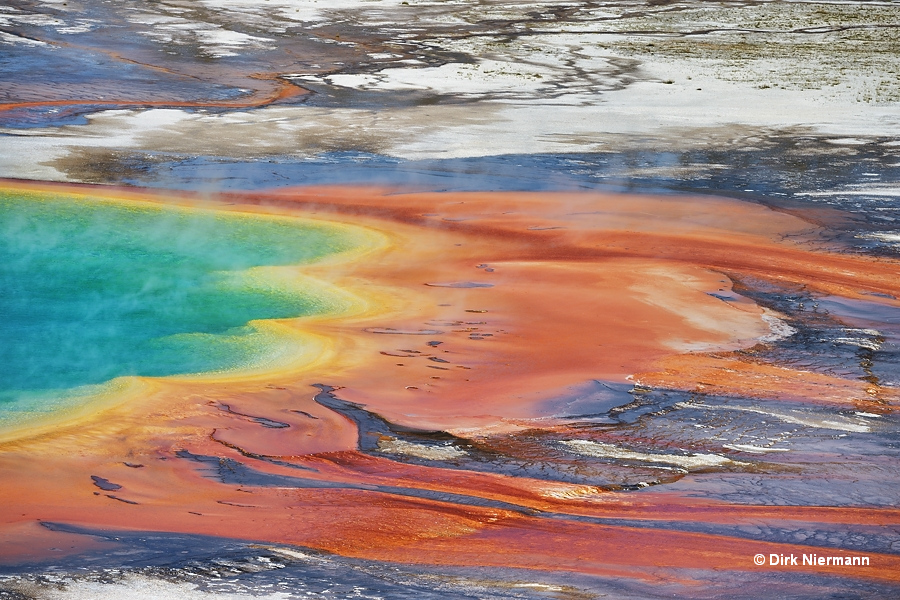
In contrast to the almost sterile blue water in center, whose temperature reaches 87 °C (189 °F) in the depth near the vent, the internal slopes and even sections of the bottom of Grand Prismatic Spring may also be colonized by microbes. The two shown telephoto shots of the shore suggest the growth of microbial mats in the water covered littoral zone, however, for deeper sections this has not yet been confirmed. Besides the already mentioned Thermus aquaticus the presence of pale hyperthermophilic bacteria from the group of Aquificales such as Thermocrinis or Hydrogenobacter can be expected, parallelling the except size very similar Octopus Spring in White Creek Group.
In August 2014, a Dutch tourist crashed a remote-controlled DJI Phantom camera drone into Grand Prismatic Spring, only two months after the US National Park Service had banned all drones from the parks. Although great efforts were made to locate the drone inside the spring by a helicopter and by visual observation from the ground, it could neither be recovered nor be detected at all. Experts fear that the drone may release pollutants and harm the sensitive microbe communities of the spring.
Besides Excelsior Geyser the very colorful Opal Pool is the second geyser on location. Its eruptions are rare, though, only a few times per year, and years of complete dormancy are also known.
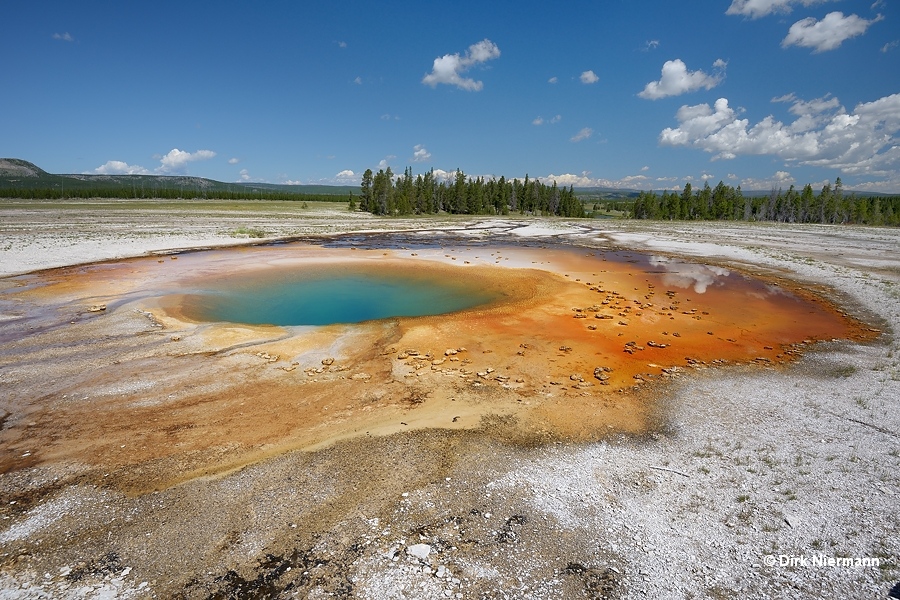
A little bit off the boardwalk is Turquoise Pool, a quiet hot spring.
